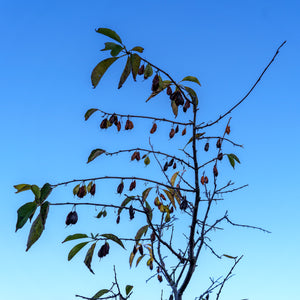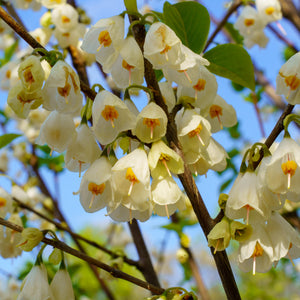The Silverbell Guide
Silverbells, a group of captivating deciduous trees, bring a delicate beauty to any landscape. Known for their graceful form, clusters of bell-shaped white blossoms, and unique fruit capsules, silverbells are a versatile and valuable addition to gardens and outdoor spaces. They brighten landscapes with their charming spring blooms, creating a stunning display. Whether planted as ornamental trees or integrated into larger landscape designs, silverbells offer both aesthetic appeal and ecological benefits.
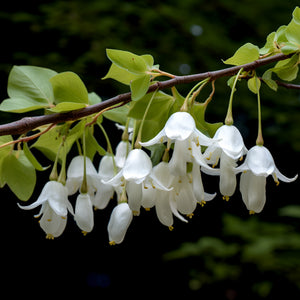
About
Silverbells, part of the Halesia genus within the Styracaceae family, encompass a diverse range of deciduous trees celebrated for their elegance and ecological importance. This group includes several recognized species found across North America and other temperate regions. Silverbells are renowned for their clusters of pendulous, bell-shaped white flowers that grace the branches in spring, creating a breathtaking seasonal display. As the growing season continues, their foliage transitions through lush shades of green, adding a layer of beauty throughout the year.
Silverbells play a significant role in local ecosystems, providing both food and habitat for various wildlife. The nectar-rich flowers attract pollinators, while the distinctive fruit capsules offer sustenance to birds and other animals. Their ability to adapt to a variety of soil types and environmental conditions, combined with a modest growth rate, makes them an excellent choice for ornamental landscaping and ecological restoration projects. Whether used as individual ornamental trees or part of a larger landscape design, silverbells stand out for their visual appeal and ecological contributions.
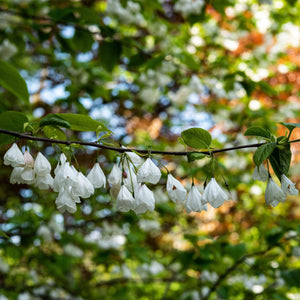
Planting
Silverbells have specific requirements to ensure successful establishment and growth. Here are some general guidelines for planting and caring for silverbells:
Soil: Silverbells thrive in well-drained soil rich in organic matter. They typically prefer slightly acidic soil with a pH between 5.0 and 6.5. Before planting, prepare the site by loosening the soil and incorporating compost or organic material to improve drainage and enhance fertility.
Sunlight: Silverbells do best in full sun to partial shade. Choose a location that receives at least six hours of direct sunlight per day for optimal growth. While they can tolerate partial shade, more sunlight often results in better flowering and fruiting.
Watering: Proper watering is essential, especially during the initial establishment of silverbells. After planting, water deeply and continue regular irrigation throughout the first year. Deeply water once or twice a week, adjusting based on rainfall and soil moisture levels. Keep the soil consistently moist but avoid waterlogging, as this can lead to root rot.
Mulching: Apply a layer of organic mulch—such as wood chips, bark, or compost—around the base of your silverbells. Mulching helps conserve moisture, suppress weeds, and regulate soil temperature. Keep mulch a few inches away from the trunk to avoid excess moisture buildup.
Pruning: Silverbells generally need minimal pruning. Focus on removing any dead, damaged, or crossing branches to maintain a strong and balanced structure. Prune in late winter or early spring while the tree is dormant, before new growth appears.
By following these planting and care guidelines, you can ensure the successful establishment and healthy growth of your silverbells, allowing them to flourish and enhance the beauty of your landscape for years to come.
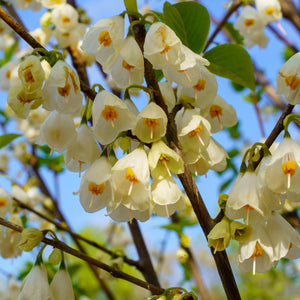
Care
Silverbells require specific care to ensure their optimal growth and health. Here are some general guidelines for maintaining silverbells:
Watering: During the growing season, provide moderate watering to your silverbells. Aim for about one inch of water per week, adjusting as needed based on rainfall. Deep watering is essential to encourage strong root development. Avoid shallow watering, as it can lead to surface roots and stress, especially during droughts or high temperatures. Be prepared to increase watering when necessary to keep the soil consistently moist.
Pruning: Silverbells typically require minimal pruning. Remove any dead, damaged, or crossing branches to maintain health and aesthetics. Pruning can also help shape the tree to your desired form. It’s best to prune during late winter or early spring, while the tree is still dormant and before new growth begins. Use clean, sharp tools to minimize damage. Deadheading spent flowers may encourage new growth and potentially a second bloom.
Fertilizing: Fertilizing can boost healthy growth and flowering in silverbells. Use a balanced, slow-release fertilizer in spring or early summer, following the manufacturer’s instructions. Avoid over-fertilizing, as it may damage the roots. If uncertain, err on the side of using less fertilizer to prevent overfeeding.
Soil and Sunlight: Silverbells prefer well-drained, moist soil and thrive with full sun or partial shade. While they adapt to a range of soil types, ensuring good drainage is crucial. Mulching around the base helps retain moisture and regulate soil temperature.
Pests and Diseases: Silverbells are generally resistant to pests and diseases, but it's wise to stay vigilant for common problems such as aphids, powdery mildew, and rust. If signs of damage or disease appear, treat promptly with the appropriate insecticides or fungicides to prevent further issues.
By adhering to these care guidelines, your silverbells will flourish, adding beauty, seasonal interest, and a graceful presence to your garden for years to come.
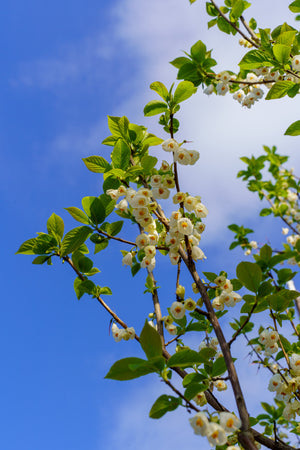
How To Use
Silverbells offer versatility and can be used in a variety of ways to enhance your landscape. Here are some recommendations based on their characteristics:
Focal Point: Silverbells have a striking presence, making them ideal as focal points in your landscape. Plant a single silverbell in an open area to showcase its graceful form and attractive foliage, or create a dramatic visual impact by planting a group of silverbells together.
Shade Provider: With broad, dense canopies, silverbells offer excellent shade. Position them strategically near patios, decks, or outdoor seating areas to create a cool, comfortable space for enjoying hot summer days.
Windbreak: The dense growth and sturdy branches of silverbells make them effective as windbreaks. Plant them in rows to shield your garden or home from strong winds, providing a natural barrier and added protection.
Privacy Screen: Use the dense foliage of silverbells to create a natural privacy screen. Plant them along property lines to form an attractive and functional barrier that enhances both privacy and aesthetics.
Wildlife Habitat: Silverbells contribute to the biodiversity of your garden by attracting a variety of wildlife. Birds and other animals are drawn to the shelter provided by these trees. By planting silverbells, you create a welcoming habitat and enjoy the lively sounds and sights of wildlife in your outdoor space.
When selecting silverbells for your landscape, consider their growth rate and environmental needs. Plant them in areas with full sun or partial shade and well-drained soil. With their graceful form, appealing foliage, and practical benefits, silverbells are an outstanding choice to elevate the beauty and functionality of your outdoor environment.
Conclusion
Silverbells are a beautiful and versatile addition to any landscape. Their striking presence, distinctive foliage, and ecological importance make them a sought-after choice for a variety of settings. By following proper planting and care practices, you can enjoy the beauty and benefits of silverbells in many ways—whether creating a picturesque pathway or establishing a cool retreat in your backyard. Whether showcased as elegant focal points or integrated into a larger landscape design, silverbells offer endless opportunities to enhance the charm of your outdoor space. With attention and care, you can cultivate a stunning landscape that brings lasting joy for years to come.

